This activity was developed by Daniel Brendle-Moczuk and is posted here with permission and extra background information. Daniel is the geospatial librarian at the University of Victoria in BC, Canada, and studies plastic pellet pollution with the Surfrider Foundation of Vancouver Island. He specializes in geography and environmental studies. The original PDF of the activity embedded at the bottom of the page contains Daniel's contact information.
Objectives
- Identify and sort plastic debris into seven standard polymer categories
- Rank the collected plastic polymer debris by mass
This activity offers an accessible way to analyze plastic debris by sorting it into categories of likely plastic polymers. You might do this activity if you've collected microplastics locally and want to identify what kind of common plastic polymers are in your sample.
Background
Plastics are made of materials called polymers, and a variety of polymers are used to make common plastic products. In many countries, these plastic products are commonly coded and labelled by the kind of polymer they contain, which appears as an identification symbol on the item: a number from 1-7 inside a triangle of chasing arrows. This numbering system, called the Resin Identification Code, was developed by the plastics industry. Each plastic polymer in the coding system has its own chemical makeup and density (expressed as mass per volume).
List of polymer symbols
- #6-PS-foam: polystyrene foam
- #5-PP: polypropylene
- #4-LDPE: low density polyethylene
- #2-HDPE: high density polyethylene
- #7-PC: polycarbonate
- #1-PETE: polyethylene terephthalate
- #3-V-rigid: rigid vinyl (polyvinyl chloride, PVC)
- #7-ABS: acrylonitrile butadiene styrene
- #3-V-flexible: flexible vinyl (polyvinyl chloride, PVC)
- #6-PS-solid: solid polystyrene
In this activity, you'll place small pieces of unidentified plastic debris into containers with liquids of different, known densities. Whether the plastic item sinks or floats as you progress through each test liquid will help narrow down which polymer category the plastic item likely belongs to.
Materials needed
- Bucket or container wide enough to use with a sieve (for use with water)
- Sieves (2)
- Paper towels
- Clear narrow, small, tall bottles or containers with lids (for use with six separate liquids of various densities)
- Containers with lids to store debris once sorted (10-12)
- Tweezers (label all tweezers for use only with one of the specific liquids below)
- Liquids of different densities:
- Canola (cooking) oil
- Castor oil
- Water
- Liquid dish hand detergent (not dishwasher soap)
- Glycerin
- Light corn syrup
- Dark pancake syrup
- A scale (for Part D: ranking collected debris by mass. You can still do the sorting and identifying parts of the activity without a scale.)
Safety: all materials are consumer products but are messy; safety goggles should be worn.
Limitations: some debris may have air or grit thus affecting density; all densities are approximate at room temperature.
Procedure
Pre-lab preparation
- Label clear narrow, small, tall bottles/containers (and their lids) with each of the six liquids listed above (except water).
- Pour liquids half-way into individual containers as labelled.
General guidelines
The procedure is split up into Parts A, B, C, and D. You'll place plastic debris into liquids of various densities to observe if the debris floats or sinks. Use appropriately labelled tweezers with matching liquid.
After Part A, debris that floats will be wiped or rinsed and placed into the next liquid. Debris that sinks will be left in the liquid until the container is almost "full" with other debris of same polymer symbol #; when "full", pick out the debris, clean it off and store it in the appropriately labelled container.
Step-by-step
Part A: Broad identification
1. Add plastic debris to the wide bucket or container filled with water (density = 1.00 g/ml). Close and shake (or stir), then allow debris to settle.
2. Polymers of symbols #6-PS-foam, #5-PP, #4-LDPE & #2-HDPE will FLOAT. Polymers of symbols #7-PC, #1-PETE, #3-V-rigid, #7-ABS, #3-V-flexible, #6-PS-solid will SINK (see table below).
3. Scoop floating debris with a sieve and allow to dry.
4. Set aside in the storage container labelled floating debris symbols #6-PS-foam, #5-PP, #4-LDPE and #2-HDPE.
5. Pour water and sunken debris from the bucket/container through another sieve and allow it to dry.
6. Set aside in storage container labelled sunken debris with symbols #7-PC, #1-PETE, #3-V-rigid, #7-ABS, #3-V-flexible and #6-PS-solid.
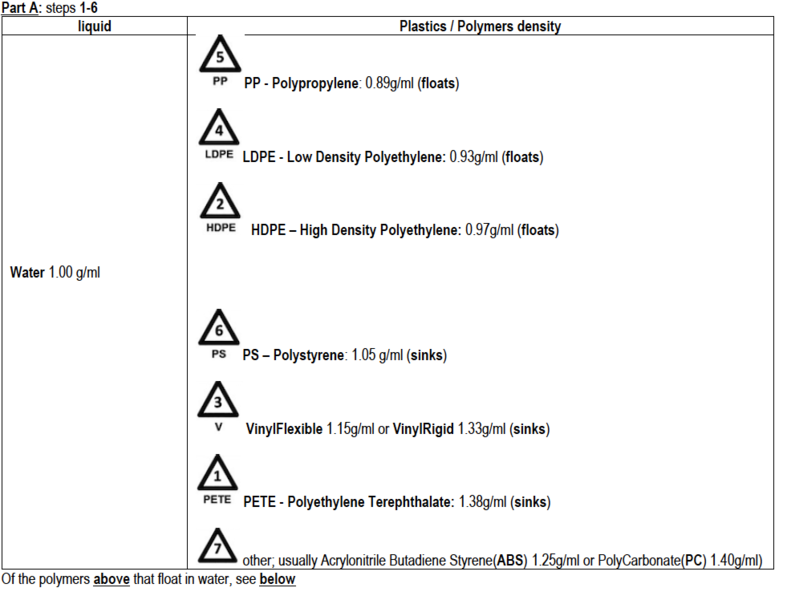
Part B: Identify polymers of symbols #6-PS-foam, #5-PP, #4-LDPE & #2-HDPE (these float in water)
7. Using tweezers designated for castor oil, place one dry individual piece of plastic polymer debris of symbols #6-PS-foam, #5-PP, #4-LDPE, and #2-HDPE (from step 4 above) halfway into the castor oil (density = 0.96 g/ml) labelled bottle/container; allow time for debris to settle.
8. If debris from step 7 FLOATS, debris is probably either #4-LDPE-Low Density Polyethylene (0.93 g/ml) or #5-PP-Polypropylene (0.89 g/ml) (see table below). Pick out debris and wipe off castor oil so debris is ready for the next liquid.
9. If debris from step 7 SINKS, it is probably #2-HDPE-High Density Polyethylene (0.97 g/ml); leave sunken debris in the castor oil as per general guidelines above.
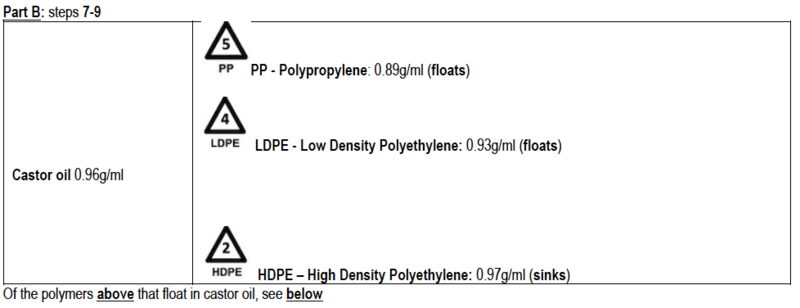
10. With tweezers for use with canola oil, place debris from step 8 halfway into canola oil (0.92g/ml) container; allow time for debris to settle.
11. If debris from step 10 FLOATS, it is probably #5-PP-Polypropylene (0.89 g/ml) (see table below); pick out debris and wipe off canola oil and store in container labelled #5-PP.
12. If debris from step 10 SINKS, it is probably #4-LDPE-Low Density Polyethylene (0.93 g/ml); leave in liquid as per general guidelines above.

Part C: Identify polymers of symbols #7-PC, #1-PETE, #3-V-rigid, #7-ABS, #3-V-flexible, #6PS-solid (these sink in water)
13. With tweezers for use with dark pancake syrup, place one dry individual piece of plastic polymer debris of symbols #7-PC, #1-PETE, #3-V-rigid, #7-ABS, #3-V-flexible, #6-PS-solid (from step 6 above) halfway in the dark pancake syrup (1.39 g/ml) labelled container; allow time for debris to settle.
14. If debris from step 13 SINKS, it is probably #7-PC-polycarbonate (1.40 g/ml) (see table below).
15. If debris from step 13 FLOATS, debris is either #1-PETE, #3-V-rigid, #7-ABS, #3-V-flexible or #6-PS-solid; pick the debris out and rinse with water so it is ready for the next liquid.
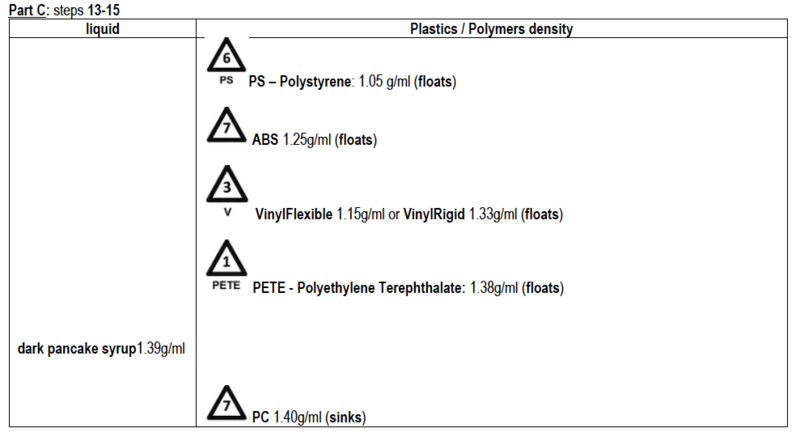
16. With tweezers for use with light corn syrup, place debris that floated in step 15 halfway in light corn syrup (1.33 g/ml); allow time for debris to settle.
17. If debris from step 16 SINKS, debris is probably #1-PETE (1.38 g/ml) (see table below).
18. If debris from step 16 FLOATS, debris is either #3-V-rigid, #7-ABS, #3-V-flexible or #6-PS-solid; pick debris out and rinse with water so it is ready for the next liquid.
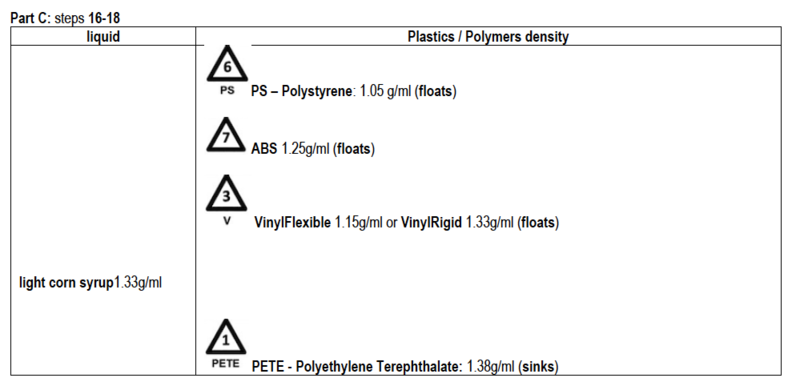
19. With tweezers for use with glycerin, place debris that floated in step 18 halfway in glycerin (1.26 g/ml); allow time to settle.
20. If debris from step 19 SINKS, debris is probably #3-V-rigid (1.33 g/ml) (see table below).
21. If debris from step 19 FLOATS, debris is either #7-ABS, #3-V-flexible or #6-PS-solid; pick debris out and rinse with water so it is ready for the next liquid.
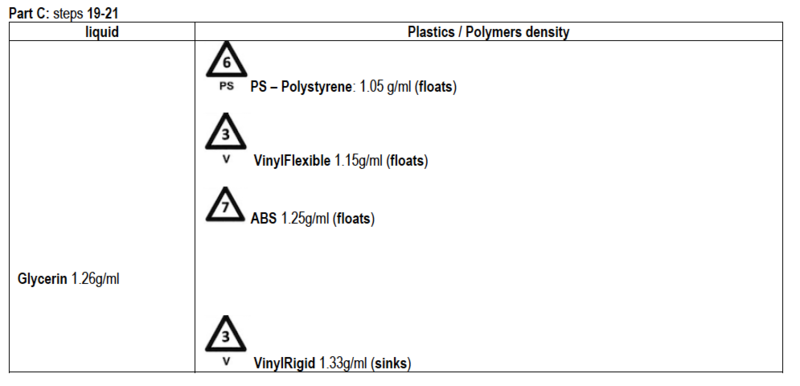
22. With tweezers for dish detergent, place debris that floated in step 21 halfway in liquid dish detergent (1.05 g/ml); allow time to settle.
23. If debris from step 22 FLOATS, it is probably #6-PS-solid; pick out and place in the storage container labelled #6-PS-solid polystyrene.
24. If debris from step 22 SINKS, it is either #7-ABS (1.25 g/ml) or #3-V-flexible (1.15 g/ml).
In this one scenario, pick out debris and rinse it with water. Try to bend the debris: if it bends it is #3-V-flexible; if not bendable/flexible, it is #7-ABS. Place the debris into their separate, labelled containers.
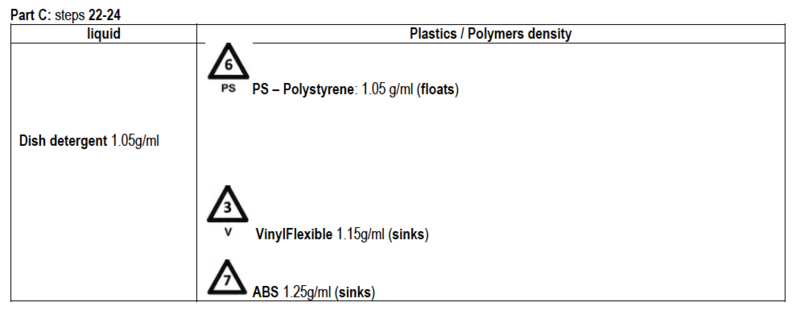
Part D: How much of each polymer type do you have? Ranking collected debris by mass
25. Separately weigh all plastic debris from each polymer symbol category and record.
26. Sum these individual masses to get the total sample mass. By mass, what percent does each # symbol represent in all the plastic debris you collected?
ORGINAL PDF:

1 Comments
This is a great learning tool! Wondering if @mimiss has had a chance to share it with educators? Could make for a great learning activity at home in makeshift learning lab. Can't wait to try it with babylegs!
Is this a question? Click here to post it to the Questions page.
Reply to this comment...
Log in to comment
Login to comment.